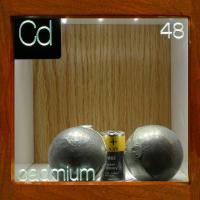Home Size: 1 2 3 4 5 6 7 8 9
|
 |
| A soft, silvery-blue metal which tarnishes in air. It is a cumulative poison and particularly toxic if inhaled.
|
|
|
 |
Balls.
These 2" cadmium balls can be bought in huge quantities (and only in huge quantities) from suppliers to the electroplating industry. They are also often available one at a time on eBay. Basically they are just pure cadmium, meant to be dissolved into an electroplating bath to be plated onto steel objects for corrosion resistance.
Source: Plating supplier
Size: 2"
Purity: 99.9%
|
|
 |
Nickel-Cadmium (NiCad) rechargeable battery.
Nickel-cadmium batteries, or "nicads" as they are often called, used to be the standard rechargeable design. These days they are being replaced by lithium ion and nickel metal hydride types - although these are currently more expensive. Unlike nicads, the new types do not suffer from the "memory" effect whereby a battery that is partially charged several times in succession can temporarily lose its ability to take a full charge. Another reason why nicads are being phased out is that they present a disposal problem. This cell contains over 10g of toxic cadmium and is likely to end up in a landfill site where it will eventually corrode and may pollute ground water.
Source: RS Components
Size: 2"
Purity: n/a
|
|

